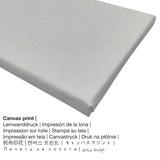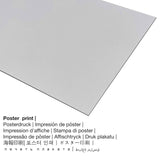Guido Reni, 1642 - Virgin and Child with Saint John the Baptist - fine art print
Taxes incluses. Frais de port calculés au paiement.
Additional information as provided by the museum (© - by The J. Paul Getty Museum - The J. Paul Getty Museum)
In this depiction of a meeting between the young Christ and Saint John the Baptist, Guido Reni eliminated unnecessary detail and concentrated on the scene's emotional qualities. The eyes of the two children meet as Mary looks on. The doves that the Christ Child gives to his cousin are an allusion to both Jesus's future role as the King of Peace as well as his eventual sacrifice. Joseph enters through a doorway in the background.
Although using oil, Reni applied his color with the broad brushwork of fresco painting. He outlined important details with dark, jagged strokes. It was once thought that the sketchy appearance of Reni's late works meant that they were unfinished, but like many aging artists, Reni pared form and color to the bare essentials for purely expressive purposes.
Lost for centuries, this painting reappeared in the possession of a family in Michigan who sold it to the Getty Museum in 1984.
Artpiece information
| Title of the artpiece: | "Virgin and Child with Saint John the Baptist" |
| Classification: | painting |
| General term: | classic art |
| Artwork century: | 17th century |
| Created in: | 1642 |
| Age of artwork: | around 370 years old |
| Exhibited in: | The J. Paul Getty Museum |
| Museum location: | Los Angeles, California, United States of America |
| Museum website: | www.getty.edu |
| License: | public domain |
| Courtesy of: | The J. Paul Getty Museum |
The painter
| Artist name: | Guido Reni |
| Aliases: | School of Guido, Quindo Rhemmy, Guido Ren, Reni Guido, Guidorenie, Guido da Bologna, scola di Reno, Reni Quido, Il Guido, Guiderone, guidoredi, Guido Bolonese, Réni dit le Guide, Guido Renie, Guido Reni ou le Guide, Guido Rheno, Guydo, Guidoreno, reni g., Guidorene, Haido reno, Guidoraine, Reni, Guido Rheni, Gueedo, guido reni bologna, Giulio Rena, Guido-Reni, Guidoren, Guido Bolanez, Guido Bollonees, Guidoreni, Guido Bologna, Guido School, Guidesco, Guidop, Guide Reni, Vidoreno, Guidi, Guido de Reny, Guido Reni dit le Guide, Reni Guido, Quido Reni, Guido Bolognes, Guido Reni Bolognese, Guide Le, Guido Reny, Guido Redi, Guido orena, Guido Vani, Leguido, Guid Reni, Guidozeni, Guide Doreni, Quido, Guido Rheny, le Quide, Giud, Huido reno, Signor Guido, Gudureno Boloneus, Reni Le Guide, G. Reni, Guidoreny, Gidoreni, Guid, Guide de Renen, Guido Bolognese, Gudio, Sig.r Guidi, Guido, Guido Bollonnes, Buide, Guido Remo, Huido reyno, Guiddo Reni, Guido René, Giulio Reno, Leguide, Guydo Reni, Giudo Reni, Du Guide, Guido Rueni, Guidoni, Guidop Reni, Guedo, Goidorino, Guido Rheni dit Le Guide, Gnido, Guido Renni, Guido Reni van Bolonge, buido, Guido Reni de Bologna, Le Guide, Guido Reno, Guido Boloneze, Guido Reyna, Grido, Guido Rini, Guido Rena, Guido Rhene, Guido Reni, Guido-Reni dit le Guide, Le Guide célèbre maître Italien, Guido Bolonois, Grido Reni, Guido R., Le Guido Rheni, Reni Il Guido, Le Guido réuni, Guide, Le Guidoreni, [Guido Reni], Guido Reno Bolognese, Le Guyde, Guido de Reyna |
| Gender: | male |
| Nationality of artist: | Italian |
| Professions of the artist: | painter |
| Country: | Italy |
| Classification: | old master |
| Art styles: | Baroque |
| Age at death: | 67 years |
| Year of birth: | 1575 |
| City of birth: | Bologna, Bologna province, Emilia-Romagna, Italy |
| Died in the year: | 1642 |
| Town of death: | Bologna, Bologna province, Emilia-Romagna, Italy |
About this product
| Product type: | art print |
| Reproduction method: | digital reproduction |
| Production method: | digital printing |
| Production: | German production |
| Stock type: | production on demand |
| Intended product use: | home design, wall gallery |
| Artwork orientation: | portrait format |
| Image ratio: | 1 : 1.2 length to width |
| Implication: | the length is 20% shorter than the width |
| Available reproduction fabrics: | canvas print, metal print (aluminium dibond), poster print (canvas paper), acrylic glass print (with real glass coating) |
| Canvas print (canvas on stretcher frame) options: | 50x60cm - 20x24", 100x120cm - 39x47", 150x180cm - 59x71" |
| Acrylic glass print (with real glass coating) options: | 50x60cm - 20x24", 100x120cm - 39x47", 150x180cm - 59x71" |
| Poster print (canvas paper) size options: | 50x60cm - 20x24", 100x120cm - 39x47" |
| Aluminium dibond print (aluminium material) size variants: | 50x60cm - 20x24", 100x120cm - 39x47" |
| Picture frame: | no frame |
Order the item material you would like to have
In the product dropdown menu you can select your prefered material and size. We allow you to pick your favorite size and material among the following product individualization options:
- Aluminium dibond: An Aluminium Dibond print is a print with an impressive depth effect. The colors of the print are luminous and vivid in the highest definition, details appear clear and crisp, and the print has a a matte look you can literally feel.
- The poster print (canvas material): The poster print is a printed sheet of flat canvas with a slightly rough surface structure. Please keep in mind, that depending on the size of the poster print we add a white margin of something between 2 - 6cm round about the painting to facilitate the framing with your custom frame.
- Acrylic glass print (with real glass coating): A glossy acrylic glass print, which is often referred to as a fine art print on plexiglass, will change an original into lovely décor and forms a distinct alternative option to dibond or canvas art prints. Our real glass coating protects your chosen fine art print against light and external influences for decades.
- Canvas: The canvas direct print is a printed cotton canvas stretched on a wooden frame. The great advantage of canvas prints is that they are relatively low in weight, which means that it is easy and straightforward to hang up the Canvas print without extra wall-mounts. That is why, a canvas print is suited for any type of wall in your home.
Virgin and Child with Saint John the Baptist is an artwork made by the painter Guido Reni in 1642. Nowadays, this artpiece is part of the digital art collection of The J. Paul Getty Museum. This public domain artpiece is being included with courtesy of The J. Paul Getty Museum.: . Besides, the alignment is portrait and has a side ratio of 1 : 1.2, which means that the length is 20% shorter than the width. Guido Reni was a male painter, whose style can primarily be attributed to Baroque. The European painter was born in 1575 in Bologna, Bologna province, Emilia-Romagna, Italy and died at the age of 67 in the year 1642 in Bologna, Bologna province, Emilia-Romagna, Italy.
Legal disclaimer: We do the best we can to describe our art products in as much detail as we can and to showcase them visually on the respective product detail pages. At the same time, the pigments of the printed materials, as well as the print result may vary to a certain extent from the image on your monitor. Depending on the settings of your screen and the quality of the surface, not all colors can be printed as exactly as the digital version shown here. Given that all are processed and printed manually, there might as well be minor variations in the motif's exact position and the size.
© Copyright protected | www.artprinta.com (Artprinta)














